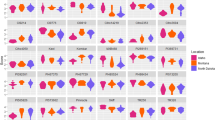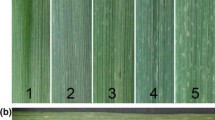Abstract
Key message
Pathogen and host genetics were used to uncover an inverse gene-for-gene interaction where virulence genes from the pathogen Pyrenophora teres f. maculata target barley susceptibility genes, resulting in disease.
Abstract
Although models have been proposed to broadly explain how plants and pathogens interact and coevolve, each interaction evolves independently, resulting in various scenarios of host manipulation and plant defense. Spot form net blotch is a foliar disease of barley caused by Pyrenophora teres f. maculata. We developed a barley population (Hockett × PI 67381) segregating for resistance to a diverse set of P. teres f. maculata isolates. Quantitative trait locus analysis identified major loci on barley chromosomes (Chr) 2H and 7H associated with resistance/susceptibility. Subsequently, we used avirulent and virulent P. teres f. maculata isolates to develop a pathogen population, identifying two major virulence loci located on Chr1 and Chr2. To further characterize this host–pathogen interaction, progeny from the pathogen population harboring virulence alleles at either the Chr1 or Chr2 locus was phenotyped on the Hockett × PI 67381 population. Progeny harboring only the Chr1 virulence allele lost the barley Chr7H association but maintained the 2H association. Conversely, isolates harboring only the Chr2 virulence allele lost the barley Chr2H association but maintained the 7H association. Hockett × PI 67381 F2 individuals showed susceptible/resistant ratios not significantly different than 15:1 and results from F2 inoculations using the single virulence genotypes were not significantly different from a 3:1 (S:R) ratio, indicating two dominant susceptibility genes. Collectively, this work shows that P. teres f. maculata virulence alleles at the Chr1 and Chr2 loci are targeting the barley 2H and 7H susceptibility alleles in an inverse gene-for-gene manner to facilitate colonization.




Similar content being viewed by others
Data availability
All data associated with this study are available in the supplementary data (Online Resource 3) or upon request from the corresponding author.
References
Burlakoti RR, Gyawali S, Chao S, Smith KP, Horsley RD, Cooper B, Muehlbauer GJ, Neate SM (2017) Genome-wide association study of spot form of net blotch resistance in the upper midwest barley breeding programs. Phytopathology 107:100–108. https://doi.org/10.1094/PHYTO-03-16-0136-R
Carlsen SA, Neupane A, Wyatt NA, Richards JK, Faris JD, Xu SS, Brueggeman RS, Friesen TL (2017) Characterizing the Pyrenophora teres f. maculata–Barley interaction using pathogen genetics. G3 Genes Genom Genet 7(8):2615–2626. https://doi.org/10.1534/g3.117.043265
Chakraborty S (2013) Migrate or evolve: options for plant pathogens under climate change. Glob Chang Biol 19:1985–2000. https://doi.org/10.1111/gcb.12205
Chisholm ST, Coaker G, Day B, Staskawicz BJ (2006) Host-microbe interactions: Shaping the evolution of the plant immune response. Cell 124:803–814. https://doi.org/10.1016/j.cell.2006.02.008
Clare SJ, Wyatt NA, Brueggeman RS, Friesen TL (2020) Research advances in the Pyrenophora teres-barley interaction. Mol Plant Pathol 21:272–288. https://doi.org/10.1111/mpp.12896
Clare SJ, Duellman KM, Richards JK, Poudel RS, Merrick LF, Friesen TL, Brueggeman RS (2022) Association mapping reveals a reciprocal virulence/avirulence locus within diverse US Pyrenophora teres f. maculata isolates. BMC Genom. https://doi.org/10.1186/s12864-022-08529-1
Dahanayaka BA, Snyman L, Vaghefi N, Martin A (2022) Using a hybrid mapping population to identify genomic regions of Pyrenophora teres associated with virulence. Front Plant Sci 13:925107. https://doi.org/10.3389/fpls.2022.925107
Faris JD, Friesen TL (2020) Plant genes hijacked by necrotrophic fungal pathogens. Curr Opin Plant Biol 56:74–80. https://doi.org/10.1016/j.pbi.2020.04.003
Flor HH (1971) Current status of the gene-for-gene concept. Annu Rev Phytopathol 9(1):275–296. https://doi.org/10.1146/annurev.py.09.090171.001423
Friesen TL, Faris JD (2021) Characterization of effector-target interactions in necrotrophic pathosystems reveals trends and variation in host manipulation. Annu Rev Phytopathol 59:4.1-4.22. https://doi.org/10.1146/annurev-phyto-120320-012807
Friesen TL, Meinhardt SW, Faris JD (2007) The Stagonospora nodorum-wheat pathosystem involves multiple proteinaceous host-selective toxins and corresponding host sensitivity genes that interact in an inverse gene-for-gene manner. Plant J 51:681–692. https://doi.org/10.1111/j.1365-313X.2007.03166.x
Friesen TL, Zhang Z, Solomon PS, Oliver RP, Faris JD (2008) Characterization of the interaction of a novel Stagonospora nodorum host-selective toxin with a wheat susceptibility gene. Plant Physiol 146:682–693. https://doi.org/10.1104/pp.107.108761
Grewal TS, Rossnagel BG, Pozniak CJ, Scoles GJ (2008) Mapping quantitative trait loci associated with barley net blotch resistance. Theor Appl Genet 116:529–539. https://doi.org/10.1007/s00122-007-0688-9
Heffelfinger C, Fragoso CA, Lorieux M (2017) Constructing linkage maps in the genomics era with MapDisto 2.0. Bioinformatics 33:2224–2225. https://doi.org/10.1093/bioinformatics/btx177
Jayasena KW, Van Burgel A, Tanaka K, Majewski J, Loughman R (2007) Yield reduction in barley in relation to spot-type net blotch. Australas Plant Path 36:429–433. https://doi.org/10.1071/AP07046
Joehanes R, Nelson JC (2008) Qgene 4.0, an extensible Java QTL-analysis platform. Bioinformatics 24:2788–2789. https://doi.org/10.1093/bioinformatics/btn523
Jones JDG, Dangl JL (2006) The plant immune system. Nature 444:323–329. https://doi.org/10.1038/nature05286
Koladia VM, Richards JK, Wyatt NA, Faris JD, Brueggeman RS, Friesen TL (2017) Genetic analysis of virulence in the Pyrenophora teres f. teres population BB25 × FGOH04Ptt-21. Fungal Genet Biol 107:12–19. https://doi.org/10.1016/j.fgb.2017.07.003
Leboldus JM, Kinzer K, Richards J, Ya Z, Yan C, Friesen TL, Brueggeman R (2015) Genotype-by-sequencing of the plant-pathogenic fungi Pyrenophora teres and Sphaerulina musiva utilizing Ion Torrent sequence technology. Mol Plant Pathol 16:623–632. https://doi.org/10.1111/mpp.12214
Li H, Durbin R (2009) Fast and accurate short read alignment with Burrows-Wheeler transform. Bioinformatics 25:1754–1760. https://doi.org/10.1093/bioinformatics/btp324
Liu ZH, Friesen TL (2010) Identification of Pyrenophora teres f. maculata ,causal agent of spot type net blotch of barley in North Dakota. Plant Dis 94(4):480–480. https://doi.org/10.1094/PDIS-94-4-0480A
Liu Z, Ellwood SR, Oliver RP, Friesen TL (2011) Pyrenophora teres: profile of an increasingly damaging barley pathogen. Mol Plant Pathol 121:1–19. https://doi.org/10.1111/j.1364-3703.2010.00649.x
Louw JP, Crous PW, Holz G (1996) Relative importance of the barley net blotch pathogens Pyrenophora teres f. teres (net type) and P. teres f. maculata (spot type) in South Africa. Afr Plant Prot 2:89–95
Lu S, Edwards MC, Friesen TL (2012) Genetic variation of single nucleotide polymorphisms identified at the mating type locus correlates with form-specific disease phenotype in the barley net blotch fungus Pyrenophora teres. Eur J Plant Pathol 135:49–65. https://doi.org/10.1007/s10658-012-0064-8
Mair WJ, Thomas GJ, Dodhia K, Hills AL, Jayasena KW, Ellwood SR, Oliver RP, Lopez-Ruiz FJ (2020) Parallel evolution of multiple mechanisms for demethylase inhibitor fungicide resistance in the barley pathogen Pyrenophora teres f. sp. maculata. Fungal Genet Biol 145:103475. https://doi.org/10.1016/j.fgb.2020.103475
Marshall JM, Kinzer K, Brueggeman RS (2015) First report of Pyrenophora teres f. maculata the cause of spot form net blotch of barley in Idaho. Plant Dis 99(12):1860. https://doi.org/10.1094/PDIS-03-15-0349-PDN
McKenna A, Hanna M, Banks E, Sivachenko A, Cibulskis K, Kernytsky A, Garimella K, Altshuler D, Gabriel S, Daly M, DePristo MA (2010) The genome analysis toolkit: a MapReduce framework for analyzing next-generation DNA sequencing data. Genome Res 20:1297–1303. https://doi.org/10.1101/gr.107524.110
McLean MS, Howlett BJ, Hollaway GJ (2009) Epidemiology and control of spot form of net blotch Pyrenophora teres f. maculata of barley: a review. Crop Pasture Sci 60:303–315. https://doi.org/10.1071/CP08173
McLean MS, Howlett BJ, Hollaway GJ (2010) Spot form of net blotch, caused by Pyrenophora teres f. maculata, is the most prevalent foliar disease in Victoria, Australia. Australas Plant Path 39:46–49. https://doi.org/10.1071/AP09054
Mikhailova LA, Ternyuk IG, Mironenko NV (2010) Pyrenophora teres, an agent causing wheat leaf spot. Microbiology 79:561–565. https://doi.org/10.1134/S0026261710040223
Muñoz-Amatriaín M, Cuesta-Marcos A, Endelman JB, Comadran J, Bonman JM, Bockelman HE, Chao S, Russell J, Waugh R, Hayes PM, Muehlbauer GJ (2014) The USDA barley core collection: Genetic diversity, population structure, and potential for genome-wide association studies. PLoS ONE 9:e94688. https://doi.org/10.1371/journal.pone.0094688
Murray GM, Brennan JP (2010) Estimating disease losses to the Australian barley industry. Australas Plant Path 39:85–96. https://doi.org/10.1071/AP09064
Neupane A, Tamang P, Brueggeman RS, Friesen TL (2015) Evaluation of a barley core collection for spot form net blotch reaction reveals distinct genotype-specific pathogen virulence and host susceptibility. Phytopathology 105:509–517. https://doi.org/10.1094/PHYTO-04-14-0107-R
Ngou BPM, Ahn HK, Ding P, Jones JDG (2021) Mutual potentiation of plant immunity by cell-surface and intracellular receptors. Nature 592:110–115. https://doi.org/10.1038/s41586-021-03315-7
Perelló AE, Couretot L, Curti A, Uranga JP, Consolo VF (2019) First report of spot lesion of wheat caused by Pyrenophora teres f. sp maculata observed in Argentina. Crop Prot 122:19–22. https://doi.org/10.1016/j.cropro.2019.03.023
Peters AR, Zhang Z, Richards JK, Friesen TL, Faris JD (2019) Genetics of variable disease expression conferred by inverse gene-for-gene interactions in the wheat-Parastagonospora nodorum pathosystem. Plant Physiol 180:420–434. https://doi.org/10.1104/pp.19.00149
Peters-Haugrud AR, Zhang Z, Friesen TL, Faris JD (2022) Genetics of the wheat-Parastagonospora nodorum interaction. Theor Appl Genet. https://doi.org/10.1007/s00122-022-04036-9
Shjerve RA, Faris JD, Brueggeman RS, Yan C, Zhu Y, Koladia V, Friesen TL (2014) Evaluation of a Pyrenophora teres f. teres mapping population reveals multiple independent interactions with a region of barley chromosome 6H. Fungal Genet Biol 70:104–112. https://doi.org/10.1016/j.fgb.2014.07.012
Smedegård-Petersen V (1971) Pyrenophora teres f. maculata f. nov. and Pyrenophora teres f. teres on barley in Denmark. Yearbook of the Royal Veterinary and Agricultural University, Copenhagen, pp 124–144
Syme RA, Martin A, Wyatt NA, Lawrence JA, Muria-Gonzalez MJ, Friesen TL, Ellwood SR (2018) Transposable element genomic fissuring in Pyrenophora teres is associated with genome expansion and dynamics of host-pathogen genetic interactions. Front Gen 9:130. https://doi.org/10.3389/fgene.2018.00130
Tamang P, Neupane A, Mamidi S, Friesen T, Brueggeman R (2015) Association mapping of seedling resistance to spot form net blotch in a worldwide collection of barley. Phytopathology 105:500–508. https://doi.org/10.1094/PHYTO-04-14-0106-R
Tamang P, Richards JK, Alhashal A, Poudel RS, Horsley RD, Friesen TL, Brueggeman RS (2019) Mapping of barley susceptibility/resistance QTL against spot form net blotch caused by Pyrenophora teres f. maculata using RIL populations. Theor Appl Genet 132:1953–1963. https://doi.org/10.1007/s00122-019-03328-x
Tóth B, Csősz M, Kopahnke D, Varga J (2008) First report on Pyrenophora teres causing lesions of wheat leaves in Hungary. Plant Pathol. https://doi.org/10.1111/j.1365-3059.2007.01746.x
Uranga JP, Schierenbeck M, Perelló AE, Lohwasser U, Börner A, Simón MR (2020) Localization of QTL for resistance to Pyrenophora teres f. maculata, a new wheat pathogen. Euphytica 216:56. https://doi.org/10.1007/s10681-020-02593-y
Velásquez AC, Castroverde CDM, He SY (2018) Plant-pathogen warfare under changing climate conditions. Curr Biol 28:R619–R634. https://doi.org/10.1016/j.cub.2018.03.054
Wang X, Mace ES, Platz GJ, Hunt CH, Hickey LT, Franckowiak JD, Jordan DR (2015) Spot form of net blotch resistance in barley is under complex genetic control. Theor Appl Genet 128:489–499. https://doi.org/10.1007/s00122-014-2447-z
Williams KJ, Lichon A, Gianquitto P, Kretschmer JM, Karakousis A, Manning S, Langridge P, Wallwork H (1999) Identification and mapping of a gene conferring resistance to the spot form of net blotch (Pyrenophora teres f. maculata) in barley. Theor Appl Genet 99:323–327. https://doi.org/10.1007/s001220051239
Williams KJ, Platz GJ, Barr AR, Cheong J, Willsmore K, Cakir M, Wallwork H (2003) A comparison of the genetics of seedling and adult plant resistance to the spot form of net blotch (Pyrenophora teres f. maculata). Aust J Agric Res 54:1387–1394. https://doi.org/10.1071/AR03028
Wyatt NA, Friesen TL (2021) Four reference quality genome assemblies of Pyrenophora teres f. maculata: a resource for studying the barley spot form net blotch interaction. Mol Plant-Microbe Interact 34:135–139. https://doi.org/10.1094/MPMI-08-20-0228-A
Wyatt NA, Richards JK, Brueggeman RS, Friesen TL (2020) A comparative genomic analysis of the barley pathogen Pyrenophora teres f. teres identifies subtelomeric regions as drivers of virulence. Mol Plant Microbe Interact 33:173–188. https://doi.org/10.1094/MPMI-05-19-0128-R
Yuan M, Jiang Z, Bi G, Nomura K, Liu M, Wang Y, Cai B, Zhou JM, He SY, Xin XF (2021) Pattern-recognition receptors are required for NLR-mediated plant immunity. Nature 592:105–109. https://doi.org/10.1038/s41586-021-03316-6
Acknowledgements
We would like to thank Danielle Holmes for technical assistance in the lab and greenhouse.
Funding
Financial support was provided by the North Dakota Barley Council, the USDA-NIFA award # 2018–67014-28491 and the National Science Foundation award # 1759030.
Author information
Authors and Affiliations
Contributions
RMS, NAW, and TLF designed the experiments. JDF and RSB generated sequencing data for the barley and P. teres markers, respectively. RMS, NAW, and GKK performed mapping, phenotyping and QTL analysis. RMS and TLF analyzed the data and wrote the manuscript. All authors edited and approved the manuscript.
Corresponding author
Ethics declarations
Conflict of interest
The authors declare that there are no conflicts of interest.
Additional information
Communicated by Reem Aboukhaddour.
Publisher's Note
Springer Nature remains neutral with regard to jurisdictional claims in published maps and institutional affiliations.
Supplementary Information
Below is the link to the electronic supplementary material.
Rights and permissions
About this article
Cite this article
Skiba, R.M., Wyatt, N.A., Kariyawasam, G.K. et al. Host and pathogen genetics reveal an inverse gene-for-gene association in the P. teres f. maculata–barley pathosystem. Theor Appl Genet 135, 3597–3609 (2022). https://doi.org/10.1007/s00122-022-04204-x
Received:
Accepted:
Published:
Issue Date:
DOI: https://doi.org/10.1007/s00122-022-04204-x




